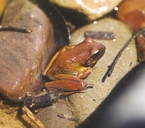|
Distribution and Habitat
Country distribution from AmphibiaWeb's database: Australia
East coast of Australia. From northern Queensland, along the New South Wales coast and into
eastern and central Victoria.
The area of occurrence of the species is approximately 767400 km2
Locally abundant. However, declines have been recorded (1970 � 1980) in the rainforests of the
Blackall and Conondale Ranges of south-eastern Queensland. More recently declines were
recorded in high altitude forests of north-eastern New South Wales.
Life History, Abundance, Activity, and Special Behaviors
Can be found in wet and dry areas of forest (dry sclerophyll to rainforest) and open areas and
heathlands, but is most common along rocky, running streams. May travel long distances from
water. Also utilises pastoral lands.
Males begin calling late in August (end winter) and through to the end of February (summer), in
warmer climates they may call through to the beginning of May. Oviposition occurs in
streamside pools and backwaters whilst the amplectant pair lies on the bottom. Eggs adhere to
submerged rocks and sediment.
Trends and Threats
Large extent of occurrence.
Threats
Fairly resilient to alterations in habitat as they are frequently found bordering urban and farming
areas. Specimens have been found infected with a chytrid fungus.
Conservation Measures
Protected where it occurs in rainforests.
References
Barker, J., Grigg, G. C., and Tyler, M. J. (1995). A Field Guide to Australian Frogs. Surrey Beatty and Sons, New South Wales.
Cogger, H.G. (1992). Reptiles and Amphibians of Australia. Reed Books, New South Wales.
Gillespie, G.R. and Hines, H.B. (1999). ''Status of temperate riverine frogs in south-eastern Australia.'' Declines and Disappearances of Australian Frogs. A. Campbell, eds., Environment Australia, Canberra, 109-130.
Hero, J.-M., Littlejohn, M., and Marantelli, G. (1991). Frogwatch Field Guide to Victorian Frogs. Department of Conservation and Environment, Victoria.
Hines, H., Mahony, M. and McDonald, K. (1999). ''An assessment of frog declines in wet subtropical Australia.'' Declines and Disappearances of Australian Frogs. A. Campbell, eds., Environment Australia, Canberra, 44-63.
Originally submitted by: Jean-Marc Hero et. al. (first posted 2002-04-05)
Edited by: Ambika Sopory (2008-09-16)Species Account Citation: AmphibiaWeb 2008 Litoria lesueurii: Lesueur's Frog <https://amphibiaweb.org/species/1264> University of California, Berkeley, CA, USA. Accessed May 9, 2025.
Feedback or comments about this page.
Citation: AmphibiaWeb. 2025. <https://amphibiaweb.org> University of California, Berkeley, CA, USA. Accessed 9 May 2025.
AmphibiaWeb's policy on data use.
|





 Map of Life
Map of Life